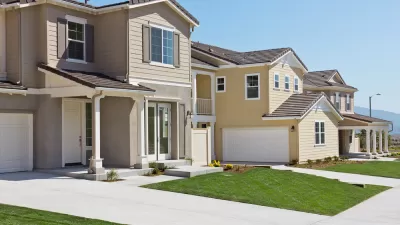Arid states can both reduce water use and avoid intrusive government by eliminating zoning regulations that mandate or encourage water-wasting lawns.

In response to California's drought, Gov. Jerry Brown recently issued an executive order proposing a wide variety of water restrictions. For example, paragraph 3 of the order provides that the state Department of Water Resources shall "lead a statewide initiative… to collectively replace 50 million square feet of lawns and ornamental turf with drought tolerant landscapes." In particular, the state will fund "lawn replacement programs in underserved communities." It is not clear from the order whether the state plans to mandate replacement of every square inch of lawn in California, or merely to fund local governments who wish to do so.
This initiative certainly seems to have reasonable goals. In fact, one-third of all residential water use involves landscape irrigation of some sort, and it seems to me that lawn-watering is a wasteful use of water compared to agriculture or bathing or drinking. But cities and states can reduce lawn-watering through means less expensive and coercive than policing individual consumption or even spending taxpayer money on lawn reform.
Some local zoning codes require homeowners to have lawns or even to water them. A drought-sensitive local government would of course eliminate such restrictions—but since not every local government is equally enlightened, California could both reduce water use and expand homeowners' rights by amending its zoning enabling legislation to prohibit local governments from enacting such restrictions. Statewide legislation would eliminate the primary excuse for lawn-watering regulations: that green lawns maintain property values. If state laws make green lawns scarce, homeowners are less likely to view green lawns as necessary for neighborhood desirability.
But even local governments without such restrictions encourage lawn creation (and thus, lawn-watering) by providing that homes and businesses be set back one or two dozen feet from streets and sidewalks. If you can’t build a house next to the sidewalk, you must put something else next to it—and that something is usually either an unsightly parking lot or a lawn.
So government could reduce the number of lawns and expand landowner rights simply by eliminating such "setback" rules and allowing landowners to build next to the street. Building that front the street have no space for lawns, and thus are likely to use less water.
In addition to reducing water consumption by reducing the number of lawns, such "zero lot line" construction would make commercial areas more pedestrian-friendly: setbacks force pedestrians to waste time walking across lawns and parking lots, thus making pedestrian commutes slightly longer and more inconvenient. In addition, setbacks reduce the amount of commerce and housing that can be built on a given plot of land, thus artificially reducing the number of jobs and residences on such land. Fewer jobs and residents per parcel mean less walkability: for example, if a office building is near a train stop, fewer tenants per office building means fewer employees who can walk to the train.*
Most commentary on California's drought has focused on state control of water use—but in fact, some regulatory reforms can both reduce water use and reduce government intrusiveness.
*I note in passing that I addressed the non-water-related harms caused by setback requirements, as well as government justifications for such rules, in this post.

Alabama: Trump Terminates Settlements for Black Communities Harmed By Raw Sewage
Trump deemed the landmark civil rights agreement “illegal DEI and environmental justice policy.”

Planetizen Federal Action Tracker
A weekly monitor of how Trump’s orders and actions are impacting planners and planning in America.

Why Should We Subsidize Public Transportation?
Many public transit agencies face financial stress due to rising costs, declining fare revenue, and declining subsidies. Transit advocates must provide a strong business case for increasing public transit funding.

Understanding Road Diets
An explainer from Momentum highlights the advantages of reducing vehicle lanes in favor of more bike, transit, and pedestrian infrastructure.

New California Law Regulates Warehouse Pollution
A new law tightens building and emissions regulations for large distribution warehouses to mitigate air pollution and traffic in surrounding communities.

Phoenix Announces Opening Date for Light Rail Extension
The South Central extension will connect South Phoenix to downtown and other major hubs starting on June 7.
Urban Design for Planners 1: Software Tools
This six-course series explores essential urban design concepts using open source software and equips planners with the tools they need to participate fully in the urban design process.
Planning for Universal Design
Learn the tools for implementing Universal Design in planning regulations.
Caltrans
Smith Gee Studio
Institute for Housing and Urban Development Studies (IHS)
City of Grandview
Harvard GSD Executive Education
Toledo-Lucas County Plan Commissions
Salt Lake City
NYU Wagner Graduate School of Public Service





























